Shivani Poddar
Harm Amplification in Text-to-Image Models
Feb 01, 2024



Abstract:Text-to-image (T2I) models have emerged as a significant advancement in generative AI; however, there exist safety concerns regarding their potential to produce harmful image outputs even when users input seemingly safe prompts. This phenomenon, where T2I models generate harmful representations that were not explicit in the input, poses a potentially greater risk than adversarial prompts, leaving users unintentionally exposed to harms. Our paper addresses this issue by first introducing a formal definition for this phenomenon, termed harm amplification. We further contribute to the field by developing methodologies to quantify harm amplification in which we consider the harm of the model output in the context of user input. We then empirically examine how to apply these different methodologies to simulate real-world deployment scenarios including a quantification of disparate impacts across genders resulting from harm amplification. Together, our work aims to offer researchers tools to comprehensively address safety challenges in T2I systems and contribute to the responsible deployment of generative AI models.
Safety and Fairness for Content Moderation in Generative Models
Jun 09, 2023



Abstract:With significant advances in generative AI, new technologies are rapidly being deployed with generative components. Generative models are typically trained on large datasets, resulting in model behaviors that can mimic the worst of the content in the training data. Responsible deployment of generative technologies requires content moderation strategies, such as safety input and output filters. Here, we provide a theoretical framework for conceptualizing responsible content moderation of text-to-image generative technologies, including a demonstration of how to empirically measure the constructs we enumerate. We define and distinguish the concepts of safety, fairness, and metric equity, and enumerate example harms that can come in each domain. We then provide a demonstration of how the defined harms can be quantified. We conclude with a summary of how the style of harms quantification we demonstrate enables data-driven content moderation decisions.
Unsupervised Topic Segmentation of Meetings with BERT Embeddings
Jun 24, 2021
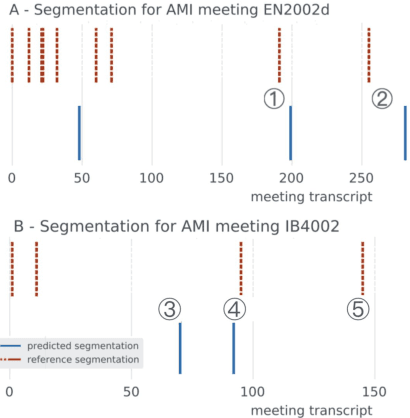
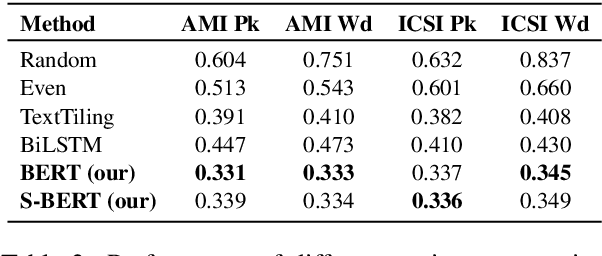
Abstract:Topic segmentation of meetings is the task of dividing multi-person meeting transcripts into topic blocks. Supervised approaches to the problem have proven intractable due to the difficulties in collecting and accurately annotating large datasets. In this paper we show how previous unsupervised topic segmentation methods can be improved using pre-trained neural architectures. We introduce an unsupervised approach based on BERT embeddings that achieves a 15.5% reduction in error rate over existing unsupervised approaches applied to two popular datasets for meeting transcripts.
Overview of the Ninth Dialog System Technology Challenge: DSTC9
Nov 12, 2020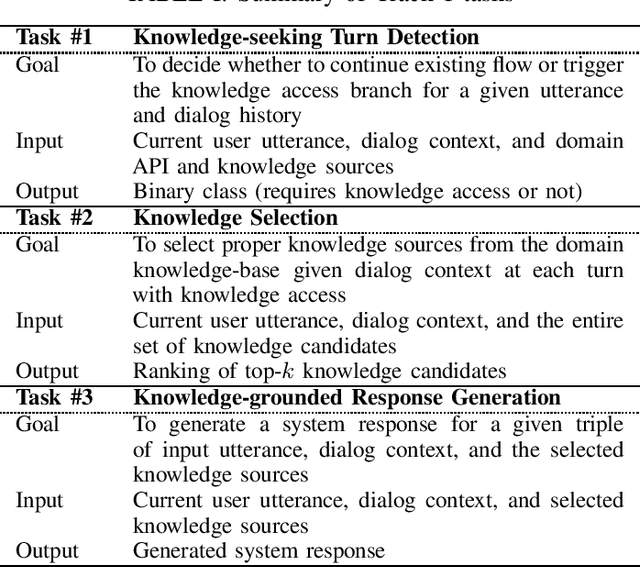


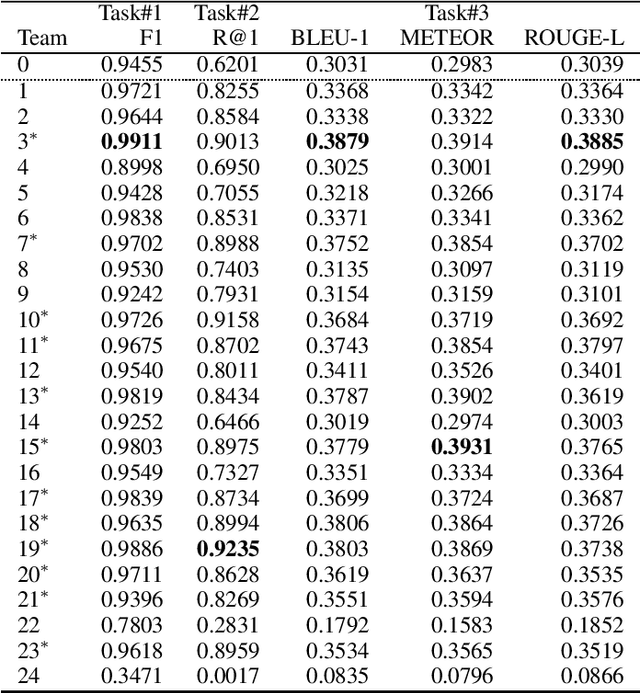
Abstract:This paper introduces the Ninth Dialog System Technology Challenge (DSTC-9). This edition of the DSTC focuses on applying end-to-end dialog technologies for four distinct tasks in dialog systems, namely, 1. Task-oriented dialog Modeling with unstructured knowledge access, 2. Multi-domain task-oriented dialog, 3. Interactive evaluation of dialog, and 4. Situated interactive multi-modal dialog. This paper describes the task definition, provided datasets, baselines and evaluation set-up for each track. We also summarize the results of the submitted systems to highlight the overall trends of the state-of-the-art technologies for the tasks.
Situated and Interactive Multimodal Conversations
Jun 02, 2020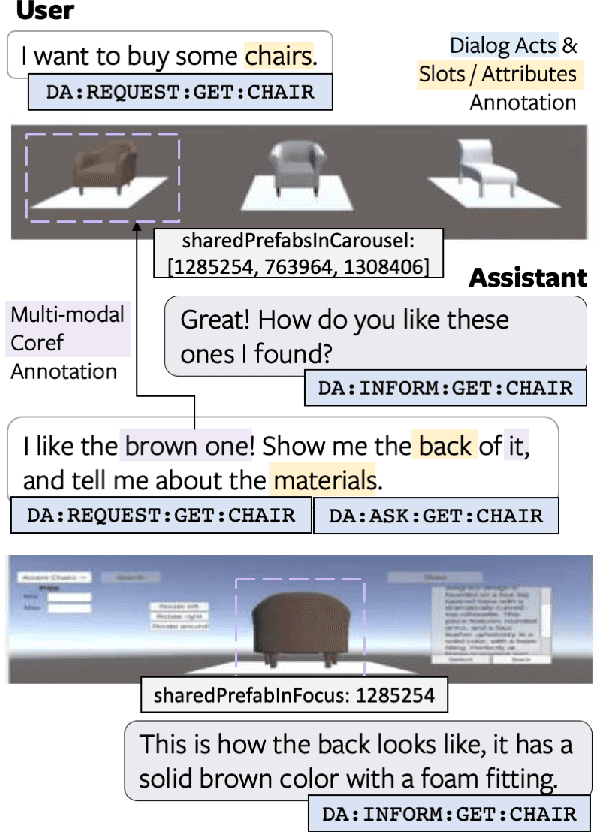


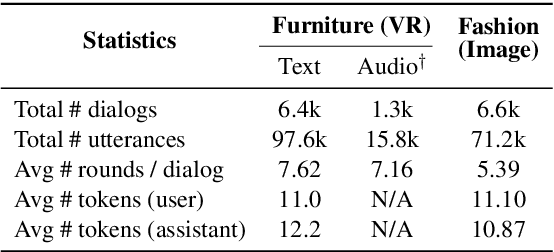
Abstract:Next generation virtual assistants are envisioned to handle multimodal inputs (e.g., vision, memories of previous interactions, etc., in addition to the user's utterances), and perform multimodal actions (e.g., displaying a route in addition to generating the system's utterance). We introduce Situated Interactive MultiModal Conversations (SIMMC) as a new direction aimed at training agents that take multimodal actions grounded in a co-evolving multimodal input context in addition to the dialog history. We provide two SIMMC datasets totalling ~13K human-human dialogs (~169K utterances) using a multimodal Wizard-of-Oz (WoZ) setup, on two shopping domains: (a) furniture (grounded in a shared virtual environment) and, (b) fashion (grounded in an evolving set of images). We also provide logs of the items appearing in each scene, and contextual NLU and coreference annotations, using a novel and unified framework of SIMMC conversational acts for both user and assistant utterances. Finally, we present several tasks within SIMMC as objective evaluation protocols, such as Structural API Prediction and Response Generation. We benchmark a collection of existing models on these SIMMC tasks as strong baselines, and demonstrate rich multimodal conversational interactions. Our data, annotations, code, and models will be made publicly available.
SIMMC: Situated Interactive Multi-Modal Conversational Data Collection And Evaluation Platform
Nov 07, 2019
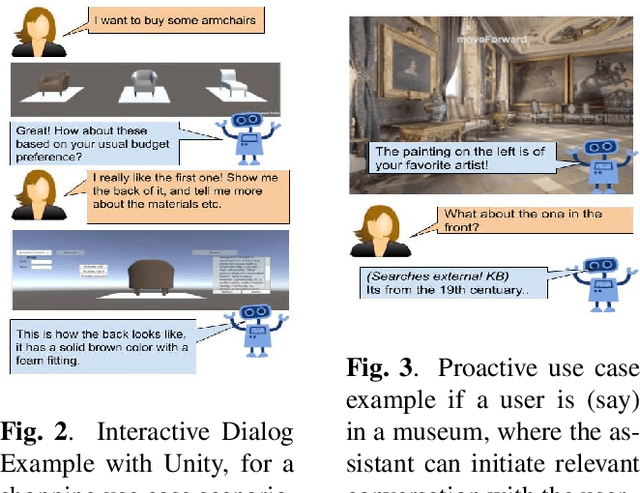
Abstract:As digital virtual assistants become ubiquitous, it becomes increasingly important to understand the situated behaviour of users as they interact with these assistants. To this end, we introduce SIMMC, an extension to ParlAI for multi-modal conversational data collection and system evaluation. SIMMC simulates an immersive setup, where crowd workers are able to interact with environments constructed in AI Habitat or Unity while engaging in a conversation. The assistant in SIMMC can be a crowd worker or Artificial Intelligent (AI) agent. This enables both (i) a multi-player / Wizard of Oz setting for data collection, or (ii) a single player mode for model / system evaluation. We plan to open-source a situated conversational data-set collected on this platform for the Conversational AI research community.
Attentive Interaction Model: Modeling Changes in View in Argumentation
Apr 18, 2018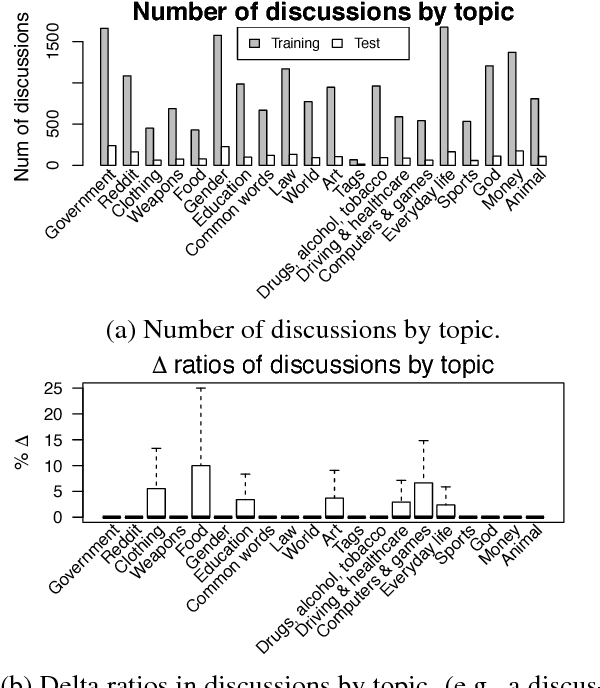
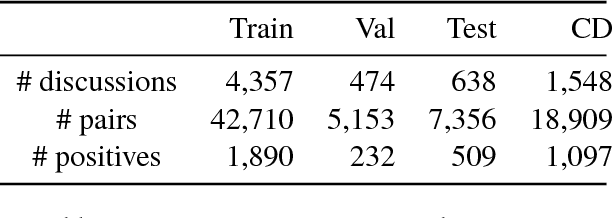
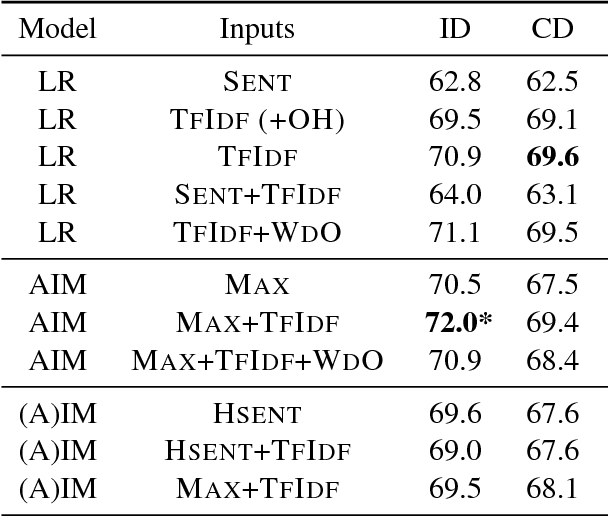
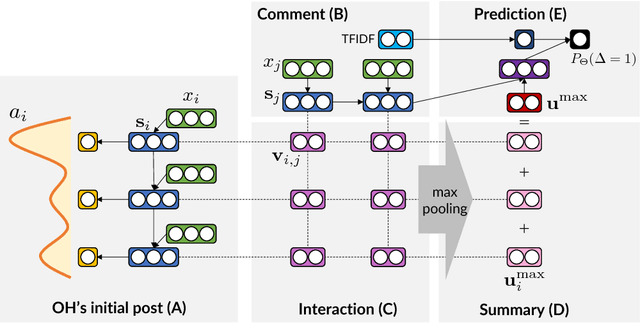
Abstract:We present a neural architecture for modeling argumentative dialogue that explicitly models the interplay between an Opinion Holder's (OH's) reasoning and a challenger's argument, with the goal of predicting if the argument successfully changes the OH's view. The model has two components: (1) vulnerable region detection, an attention model that identifies parts of the OH's reasoning that are amenable to change, and (2) interaction encoding, which identifies the relationship between the content of the OH's reasoning and that of the challenger's argument. Based on evaluation on discussions from the Change My View forum on Reddit, the two components work together to predict an OH's change in view, outperforming several baselines. A posthoc analysis suggests that sentences picked out by the attention model are addressed more frequently by successful arguments than by unsuccessful ones.
 Add to Chrome
Add to Chrome Add to Firefox
Add to Firefox Add to Edge
Add to Edge